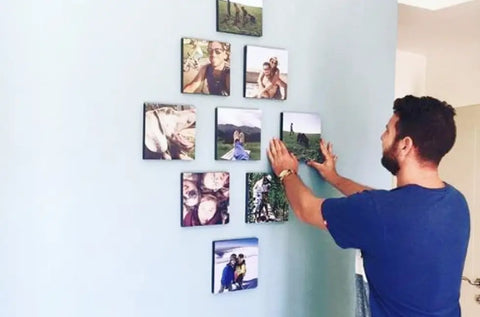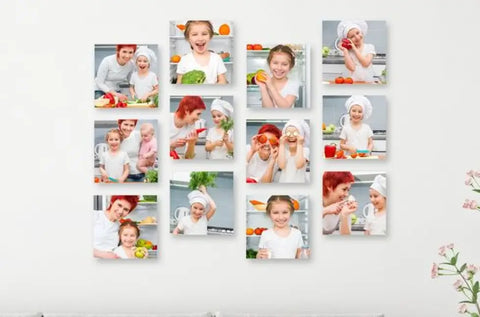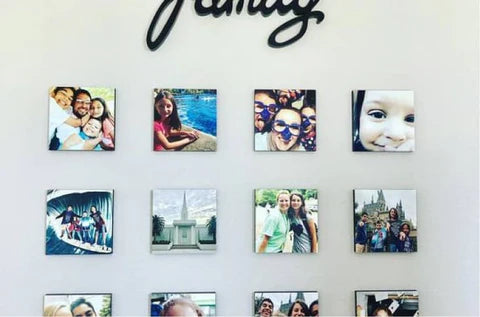
Add Photos

We Deliver

You Stick
4.9 Stars, over 100k customer reviews
Happy Customers, Happy Homes!





Reviews That Made Our Day
We love seeing your beautiful Wallpics walls!

A Game Changer! The stickable photo tiles have transformed my dull walls into a beautiful mosaic of memories. Super easy to apply and they look fantastic!
 (4.9/5)
(4.9/5)

Sarah W.

Absolutely Love It! I ordered a set of tiles and I'm amazed by the quality. The adhesive is strong, and my pictures look sharp. My living room now tells my story
 (4.9/5)
(4.9/5)

David P.

Simple Elegance. The whole process was a breeze - from uploading my photos to receiving the tiles. They exude a simple elegance that adds a unique touch to my home
 (4.9/5)
(4.9/5)

Laura M.

Great Value! I was skeptical about the pricing, but the quality exceeded my expectations. The discount for the upgraded quality was a fantastic deal!
 (4.9/5)
(4.9/5)
Micheal R.

A Delightful Experience. From order to delivery, it was seamless. The joy of sticking my favorite memories on the wall is incomparable. Highly recommended!
 (4.9/5)
(4.9/5)

Jsessica K
Celebrities Love Wallpics
We love seeing your beautiful Wallpics walls!















Rated 4.9 on the Appstore
Based on 80,000+ Reviews




Rated Excellent on Trustpilot
Based on 10,000+ Reviews
Square Photo Prints
Why I Love the Square Photo Format and Square Photo Prints
Since I first discovered mobile photography apps that emphasized the square frame, I quickly became fascinated with how much impact such a simple change in proportions could have on an image. Over time, that fascination grew beyond the act of simply shooting photos on a phone. It evolved into an appreciation for physical prints—especially square photo prints—that allow these compositions to live outside of screens and become tactile pieces of art. The square frame feels both classic and modern, and when you hold a print in your hand or see it on the wall, it carries a balance that few other formats achieve.
This article dives deeply into the history, the visual impact, and the many practical ways you can use the square format in photography. Along the way, I’ll explore why printing photos in square formats matters so much, what kinds of print sizes and styles exist today, and how they help photographers and everyday creators alike transform their digital moments into lasting works of art.
A Little History of the Square Photo Format
Square photographs may feel modern because of their revival in social media apps, but in truth they have a long and fascinating lineage that stretches back nearly a century. The story of the square format is both technical and cultural, blending the evolution of camera technology with the artistic choices of generations of photographers. What feels to many like a trendy aesthetic today is actually the continuation of a long-standing tradition in visual storytelling.
The format rose to prominence in 1929 when Rollei introduced one of the earliest twin-lens reflex cameras. This camera used medium format film and produced square negatives, a revolutionary step at the time. Photographers discovered that the square frame allowed them to work more intuitively. Unlike rectangular formats, where decisions had to be made about whether to hold the camera horizontally or vertically, the square eliminated that dilemma altogether. The act of shooting became more fluid, with the photographer focusing entirely on the subject and composition rather than orientation. This subtle difference had a major influence on the way people captured the world around them.
As the years went on, the square format became a staple in both professional and amateur photography. Cameras such as the Hasselblad, famous for their impeccable quality and craftsmanship, helped cement the format’s reputation in serious artistic and commercial circles. Fashion photographers embraced it for its symmetry and clean lines, producing iconic editorial spreads where the balance of the square brought drama and focus to the model and clothing. Documentary photographers used it to tell stories with a sense of stability and intimacy, capturing street scenes, portraits, and pivotal historical moments in a way that felt timeless.
At the same time, the square wasn’t just for professionals. On the opposite end of the spectrum, toy cameras like the Holga also made use of square film. These cameras were known for their unpredictability—light leaks, soft focus, and vignetting created images that were raw, moody, and often filled with happy accidents. While far from technically perfect, the Holga embraced the square format’s accessibility and inspired countless hobbyists to experiment. This dual identity—sophisticated and professional on one hand, playful and experimental on the other—gave the square format a versatility few other ratios could match.
The cultural importance of the square continued to grow throughout the 20th century. In fact, some of the most famous images ever taken were shot in square format. Consider the photographs from NASA’s Apollo missions: astronauts used Hasselblad cameras to document the lunar surface, and those square-framed images became visual symbols of human achievement. The square’s balanced proportions made them both practical for scientific purposes and aesthetically powerful as works of art. When people around the world first saw Earth from space, suspended in blackness, it was within a square frame that emphasized harmony and wholeness.
Even beyond iconic historical moments, the square format worked its way into family life. Countless people’s photo albums from the mid-20th century are filled with square snapshots produced by medium format film cameras. These images—birthdays, holidays, vacations—were personal stories preserved in squares. The format became synonymous with nostalgia, with many families associating it with their childhood memories and treasured keepsakes.
By the late 20th century, rectangular formats gained dominance as 35mm film cameras took over the mainstream market. The rectangular frame was efficient and practical, fitting widescreen cinematic tastes as well as everyday snapshots. For a while, the square fell somewhat out of favor, reserved mostly for professionals who still used medium format film or for niche enthusiasts experimenting with toy cameras. Yet, despite this decline, the square never disappeared entirely. It remained in the background, waiting for a resurgence.
That resurgence arrived with the digital era. Social media platforms, particularly those built around photography, reignited public interest in the square format. When apps began enforcing a square crop for uploads, billions of users suddenly had to think within that frame. A new generation of photographers—many of whom had never shot film—learned to see their world in squares. Everyday moments like meals, pets, travels, and city streets were distilled into balanced, shareable squares that felt both modern and classic at the same time.
This cultural return to the format also spurred a fresh demand for physical prints. People no longer wanted to limit their images to screens; they wanted tangible keepsakes that reflected the aesthetic they loved online. Square photo prints became a natural answer, allowing the digital square to become a physical object. The popularity of prints in sizes like 4x4, 8x8, and 12x12 demonstrates just how strongly the square continues to resonate. In many ways, this trend brought the story full circle: from film negatives in the early 20th century, to digital screens in the 21st, and back again to prints that can be held, framed, or hung on walls.
The square format’s history is not just about cameras and technology—it is also about perception. Throughout time, humans have associated the square with stability, order, and balance. Architects, designers, and artists have used squares to structure their work, relying on its symmetry to create harmony. In photography, this cultural symbolism translates into images that feel intentional, complete, and enduring. That is why, even after decades of changing trends and technologies, the square format remains so beloved.
Ultimately, the square is a timeless way of seeing the world. Its history connects pioneers of early photography, professionals chasing perfection, amateurs playing with creativity, and modern digital users sharing their lives online. It is a format that adapts to each generation while retaining its essential qualities: balance, simplicity, and universality. And as long as people continue to tell stories with images, the square will hold its place as one of the most meaningful frames in photography.
The Aesthetic of Simplicity and Balance
One of the greatest appeals of the square format in photography is its inherent sense of balance. Unlike a 4:3 or 3:2 rectangle, which tends to pull the viewer’s eye toward one axis—horizontal or vertical—the square is neutral. It does not privilege width or height. Instead, it creates a space where the viewer’s attention is naturally drawn to the center, and from there, the eye is free to explore outward in all directions. This absence of directional bias is one of the key reasons the square feels timeless, universal, and pleasing to so many.
When working within a rectangular frame, photographers are often guided by the format’s implied orientation. A horizontal frame favors landscapes, wide perspectives, and scenes where movement across the frame is important. A vertical frame, on the other hand, emphasizes height, grandeur, and subjects that stretch upward. Both orientations can be powerful, but both also impose a directional reading of the image. The viewer is subtly nudged either left-to-right or bottom-to-top. With the square, that nudge disappears. The frame is democratic, allowing every part of the composition equal weight.
This neutrality is why the square format often pairs so well with symmetry. A face placed directly in the middle of a square photograph immediately commands attention, with equal amounts of space above, below, and to the sides. A building photographed head-on gains an almost architectural purity in the square, with vertical and horizontal lines meeting in perfect equilibrium. The format supports centered compositions that might feel static or awkward in rectangles but instead come alive in the balanced square.
Yet the square does not demand symmetry. Its strength lies in its flexibility. Because there is no directional bias, asymmetrical arrangements can also thrive. A subject placed slightly off-center can feel more dynamic in a square, because the surrounding space carries equal importance. Photographers often speak of “breathing room” in composition, and the square offers this in abundance. Negative space around a subject is not wasted but elevated, becoming an essential part of the story the image tells.
|
Related Categories:
|
Simplicity is another hallmark of the square aesthetic. When cropping an image into a square, unnecessary clutter at the edges of the frame is often eliminated. Stray distractions, whether they are patches of sky, stretches of empty road, or irrelevant details, fall away. What remains is the essence of the photograph, distilled and direct. This act of reduction often strengthens the emotional and visual impact of the image. The square does not invite the photographer to fill space for the sake of filling space; instead, it encourages focus, minimalism, and clarity.
This pursuit of simplicity has historical echoes in art and design beyond photography. The square has long been a symbol of stability and order. In architecture, the square forms the foundation of countless structures, representing solidity and permanence. In graphic design, squares are used to organize content into balanced grids, ensuring harmony and readability. In abstract painting, artists like Piet Mondrian used squares to convey universal balance and purity of form. By choosing the square format in photography, creators tap into this deep cultural association with order and simplicity, which viewers often recognize instinctively even if they cannot articulate it.
When these images are translated into prints, the qualities of simplicity and balance are magnified. Holding a small square print in your hand, you feel its compact perfection. The image has no wasted edges, no awkward empty space. Enlarged on a wall, the effect is even more striking. Large square prints have a calm presence that commands attention without overwhelming the viewer. Unlike wide panoramas that demand scanning from end to end, the square feels self-contained, inviting you to step closer and immerse yourself in its world.
What’s remarkable is how even the most ordinary snapshots gain weight when framed by a square. A picture of a cup of coffee, a child’s toy, or a flower in a garden takes on a new gravity. The format elevates the mundane, imbuing it with the stability and quiet confidence of a balanced shape. For many photographers, this is part of the joy: discovering that their everyday surroundings contain hidden compositions that flourish within the square.
The square also fosters a more contemplative way of seeing. Because the viewer’s eye is not pushed along a directional path, it lingers. The viewer has time to examine details, textures, and relationships between elements. In a world where images flash by at lightning speed, this slower, more meditative engagement is refreshing. The square gently asks the viewer to pause, to look more carefully, and to notice what might otherwise go unnoticed.
This quality is perhaps why the square format remains so appealing even in our digital age. On social media feeds dominated by fleeting rectangles and videos, the square stands apart as a moment of stillness and focus. It feels intentional. When carried into the physical world through prints, that intention becomes even clearer. A wall decorated with square prints radiates order and calm. An album filled with small square prints feels cohesive and elegant, as though each image is a piece of a larger whole.
Ultimately, the aesthetic of simplicity and balance that defines the square format is not just about visual harmony. It is also about emotional resonance. By stripping away clutter, equalizing directions, and giving each element space to breathe, the square creates room for meaning. Photographs in this format often feel timeless not because of their subject matter but because of the frame itself. The square reminds us that beauty often lies in simplicity, and that balance—both visual and emotional—is something deeply human we are naturally drawn to.
Compositional Freedom with Squares
Some photographers worry that the square frame limits creativity, but in reality, the opposite is true. Far from boxing you in, the square opens doors to unique compositional strategies that rectangular formats often struggle to accommodate. Because the square is neutral—it does not favor horizontal or vertical—it gives equal weight to every edge of the frame. This neutrality allows the photographer to experiment with placement, balance, and negative space in ways that feel both liberating and intentional.
One of the most enduring compositional techniques, the rule of thirds, applies beautifully in a square. Imagine dividing the frame into a three-by-three grid: the intersections of those lines become natural points of interest. In rectangular frames, this often means choosing between left-right or top-bottom emphasis. In the square, however, you gain more flexibility. A subject placed at the upper right intersection, for example, feels perfectly balanced by the surrounding space, which doesn’t seem too wide or too tall. At the same time, placing your subject directly in the center—often discouraged in rectangles—suddenly becomes powerful in a square, producing dramatic, symmetrical impact.
Symmetry itself is one of the great gifts of the square. A centered portrait where the subject stares directly at the lens feels commanding rather than static. A tree rising in the middle of a field can dominate the frame without looking awkward. In architecture, squares accentuate facades, windows, and doors, emphasizing the geometry of manmade structures. Even reflections in water become more striking, because the equal dimensions of the frame mirror the symmetry of the subject.
But asymmetry is equally effective. Because the square does not push the eye in one direction, photographers can offset their subject to one side and allow the negative space to breathe. This is particularly effective in minimalist photography. A lone bird perched on a wire in the lower corner of a square frame feels poetic, with the surrounding emptiness carrying just as much meaning as the bird itself. Rectangular frames often make negative space feel excessive, but in a square, it becomes a crucial compositional tool.
Diagonal lines also find a natural home in the square. A road cutting across from the lower left to the upper right, or waves rolling diagonally across the sand, create a dynamic sense of motion. In rectangles, diagonals sometimes feel truncated, as though they don’t have enough space to travel. In squares, they stretch elegantly corner to corner, reinforcing the structure of the frame. Similarly, circular elements—arches, wheels, fountains—fit comfortably within a square, echoing its balance while adding visual contrast. Repeating patterns, whether tiles on a floor or windows on a building, also feel harmonious, as the square frame crops them into balanced rhythms.
This versatility explains why the square thrives across so many genres. In landscapes, mountains and reflections can be centered to emphasize symmetry, while winding paths or rivers can cut diagonally for a sense of journey. In cityscapes, tall buildings gain gravity when placed centrally, while streets and bridges provide leading lines that work across the entire frame. Portraits shine in squares because the format places equal emphasis on the subject and the environment, encouraging thoughtful framing. Architectural photography benefits immensely, as the square echoes the geometry of structures, making the image feel both modern and timeless.
Some photographers argue that the square encourages a slower, more deliberate approach to composition. Because the format is less common in everyday vision—our eyes naturally scan in wider fields—the square feels unfamiliar, almost abstract. This unfamiliarity forces you to think more carefully about placement, balance, and relationships between objects. It invites experimentation. You might tilt the camera slightly to create diagonals, crop aggressively to focus on form, or center your subject in a way that feels bold rather than obvious.
When translated into physical form, these compositions gain even more significance. Prints amplify the geometry of the square. Holding a small print in your hand, you notice how intentional the subject’s placement feels. Hanging a large square print on a wall, the balance becomes even more striking, transforming a simple scene into an artwork. Ordering square photo prints is not merely about selecting a shape; it’s about committing to a way of seeing. Each print becomes a testament to choices made in composition: where to place the subject, how to use space, and what to emphasize.
Moreover, square prints often lend themselves to series or collections. Because each square shares the same proportions, a group of them displayed together creates natural harmony. You can arrange them in grids, rows, or clusters, and the compositions will complement one another. This consistency makes square prints especially effective in storytelling projects, where each image is a chapter but the collection as a whole forms a unified narrative.
In the end, the so-called “limitations” of the square are actually opportunities. Its neutrality removes the bias of direction, allowing both symmetry and asymmetry to flourish. It enhances diagonals, elevates circles, and makes negative space meaningful. It encourages slower, more thoughtful framing, helping photographers discover new possibilities in familiar subjects. And when those images are printed, the square’s compositional freedom becomes tangible—art you can hold, hang, and share.
Far from restricting creativity, the square format expands it. It invites us to see differently, to compose with intention, and to embrace balance in new ways. For photographers of all levels, from beginners with smartphones to professionals with medium format cameras, the square remains one of the most rewarding and liberating frames in the visual arts.
Shooting Landscapes in Square Format
Landscape photography has long been associated with wide horizons. From panoramic paintings to sweeping cinematic shots, the tradition has leaned toward rectangular frames that mirror the way human vision scans across a scene. Wide-angle lenses, expansive prints, and widescreen displays all reinforce this cultural expectation that landscapes must be horizontal to feel immersive. Yet, the square format provides a surprising and refreshing alternative. It challenges our assumptions about how a landscape should be viewed and offers a way to strip the scene down to its essential shapes, forms, and contrasts.
At first glance, the square may appear counterintuitive for landscapes. After all, mountains, coastlines, and valleys often stretch across wide distances. But it is precisely this tension that makes the square so effective. By removing excess space at the sides, the square frame forces the photographer to focus. What is truly important in the scene? What story needs to be told? Rather than trying to include everything, the square emphasizes select vertical or central elements such as mountains, waterfalls, or reflections, allowing them to dominate the frame in a way that feels powerful and uncluttered.
Consider a mountain rising from a still lake. In a rectangular frame, the temptation might be to include the surrounding hills, forests, or sky to convey scale. But in doing so, the mountain itself can lose its dominance. Cropped to a square, the mountain and its mirrored reflection take center stage. The symmetry of peak and waterline aligns naturally with the square’s balanced proportions, producing a calm, contemplative image that feels timeless. The square’s neutrality gives equal weight to both the upper and lower halves of the composition, allowing the reflection to shine as much as the mountain itself.
Waterfalls are another subject that thrives in the square format. The downward motion of water aligns beautifully with the vertical pull of the square. The frame encourages the viewer’s eye to move from top to bottom, tracing the water’s journey until it crashes into rocks or pools below. Including a small human figure at the bottom enhances this effect, emphasizing scale and creating a narrative about the relationship between people and nature. The square, by constraining the sides, eliminates distractions such as cliffs or vegetation, directing full attention to the spectacle of falling water.
Even iconic structures within landscapes can benefit from square compositions. Take the Golden Gate Bridge, for example. A wide rectangular frame might include extra sky, ocean, or rocks—elements that dilute the impact of the bridge itself. In a square composition, the photographer can place the bridge off-center, using waves or shoreline as leading lines to guide the eye diagonally across the frame. The result feels more distilled, as though every element has a purpose. The bridge becomes a focal point, while the surrounding landscape supports rather than overwhelms it.
This reduction of visual noise is one of the square’s greatest strengths in landscape photography. Many wide landscape shots risk becoming postcards, filled with too much detail that leaves the viewer unsure of where to look. The square forces clarity. Each corner of the frame must contribute to the whole. Negative space—such as sky, water, or snow—becomes more deliberate, acting as a counterbalance to the main subject. This encourages photographers to think carefully about composition, turning even familiar views into new visual experiences.
The square format also lends itself to more abstract interpretations of landscapes. Patterns in sand dunes, ripples on water, or the texture of a rocky cliff can fill the frame in ways that rectangles might not support as effectively. The repetition of forms within a square feels rhythmic and harmonious, turning nature’s details into almost geometric designs. In this sense, square landscapes don’t just document a place—they transform it into art.
Printing square landscapes further enhances their impact. When an image is translated from screen to paper, the calm balance of the square becomes tangible. A set of 4x4 square photo prints might be used to create a personal travel album, where each image captures a distilled essence of a place. Larger options, like 20x20 prints, can command space on a wall, presenting a waterfall, mountain, or bridge as a bold centerpiece. The square format ensures that the print feels complete and contained, regardless of size. Unlike wide panoramic prints, which often require large walls to display effectively, squares adapt more easily to different environments while maintaining their visual power.
Moreover, square prints invite curation in ways rectangular prints sometimes don’t. A series of landscapes in matching square formats can be arranged into grids or clusters, telling a visual story of a journey across different terrains. The uniformity of shape brings cohesion, while the variety of subjects provides rhythm. This makes square landscape prints ideal for both personal storytelling and gallery exhibitions.
For photographers, embracing the square in landscapes is also a mindset shift. It requires looking at familiar scenes differently, asking not “How wide can I make this?” but “How essential can I make this?” That change in approach often leads to more creative decisions. A lone tree, a single wave, or a sliver of mountain ridge might suddenly feel worthy of a dedicated frame. Instead of capturing everything, the square photographer learns to say more with less.
In conclusion, while landscape photography traditionally favors wide rectangles, the square format offers a refreshing alternative that emphasizes simplicity, balance, and clarity. By distilling scenes to their essence—mountains mirrored in lakes, waterfalls plunging downward, bridges stretching diagonally—the square invite both photographer and viewer to experience landscapes in a new way. And when brought into the physical world through prints, whether as intimate 4x4s or dramatic 20x20s, the square’s ability to highlight natural drama becomes undeniable. Far from being a limitation, the square is a tool of focus and expression, breathing new life into the timeless art of capturing the natural world.
Cityscapes and Architecture in Squares
Urban environments are some of the richest playgrounds for square photography. Cities are filled with geometry—grids of windows, diagonals of streets, towering verticals of skyscrapers, and curves of bridges—that align beautifully with the balanced proportions of the square frame. While landscapes often invite wide horizons, cityscapes thrive on structure, order, and contrast, which are all qualities the square emphasizes. By using the square format, photographers can distill the overwhelming complexity of urban life into images that feel both intentional and harmonious.
One of the most compelling aspects of photographing architecture in square format is how it highlights symmetry. Buildings, by design, are often symmetrical. A photo of a landmark like Big Ben, for instance, benefits from being placed along one edge of the square frame. The vertical tower holds its ground on one side, while foreground elements like street lamps, buses, or pedestrians can balance the opposite side. This arrangement creates equilibrium without feeling static, allowing the viewer’s eye to move naturally across the image.
Tower Bridge provides another excellent example. The sweeping lines of the river Thames cut diagonally through the square, guiding the eye upward toward the bridge’s gothic towers. Unlike a wide rectangle, which might dilute the focus with extra water or sky, the square keeps the composition tight. The lines feel harmonious rather than forced, and the interplay between structure and surrounding environment becomes more dynamic.
Beyond landmarks, squares are effective for capturing everyday city geometry. Rows of apartments, patterns of fire escapes, or the repetition of windows across a skyscraper facade all gain rhythm when cropped into a square. The repetition feels more intentional, as the equal sides of the frame amplify the sense of order. Even chaos—a crowded market, a bustling intersection—can be given structure within a square, as the format organizes visual information into a balanced grid.
The square also allows for creative play with perspective. Shooting upward between skyscrapers, the viewer’s eye is pulled toward the converging vanishing point at the center of the frame. In a rectangle, this type of shot often feels elongated or distorted, but in a square, the proportions feel more natural. Similarly, reflections in puddles, glass, or modern metallic surfaces can be centered and mirrored in ways that heighten the sense of symmetry.
Another benefit of squares in urban photography is their ability to simplify busy scenes. Cities are often visually overwhelming—signs, wires, traffic, and people compete for attention. By using a square crop, photographers can trim away distractions at the edges and focus on what matters most. For instance, a lone cyclist framed against a wall of graffiti becomes the dominant subject when unnecessary surroundings are removed. The square enforces clarity, giving even chaotic scenes a point of calm.
Light and shadow also play a unique role in cityscapes, and the square enhances this dynamic. In streets lined with tall buildings, light often falls in vertical columns, creating striking contrasts of brightness and darkness. Framed in a square, these light patterns feel stronger, as the format gives equal weight to the vertical and horizontal spaces. Night scenes, with glowing neon signs or illuminated windows, also benefit from the square’s containment. The balanced edges keep the light from feeling scattered, creating a more cohesive atmosphere.
Printing these images magnifies their architectural strength. Small square photo prints are perfect for personal albums or collections, where the geometry of the city can be revisited in intimate detail. Holding a print of a street corner, a tower, or a bridge in your hand feels like carrying a piece of the city with you. Larger prints, such as large square canvas photo prints, have an entirely different effect. Hung on a wall, they transform urban photographs into striking design pieces. A towering skyscraper rendered in a 20x20 or 30x30 canvas becomes not just a photo but a piece of modern art.
Series and grids work particularly well with square prints of cityscapes. Because every print shares the same proportions, you can assemble multiple shots—perhaps a collection of different bridges, or a study of windows from around the world—into a cohesive gallery. The consistency of format brings harmony, while the variety of subjects provides contrast. This makes square cityscapes ideal not only for home décor but also for exhibitions and professional portfolios.
The emotional resonance of square city photographs is also worth noting. Cities are places of rhythm and energy, but they can also be overwhelming. The square provides a frame of calm, a way to order the chaos. A viewer standing before a square print of a busy market or skyline doesn’t feel lost in endless detail; instead, they are guided toward the essential forms, lines, and movements. The square doesn’t strip the city of its vitality—it channels it.
Ultimately, the square format offers photographers of urban environments a tool that balances structure with creativity. It emphasizes the geometry inherent in cities, from iconic landmarks to unnoticed corners. It simplifies without oversimplifying, trims away distraction while leaving the essence intact. And when these compositions are brought into print, whether as a handful of small squares or a massive canvas centerpiece, they become lasting testaments to the beauty of built environments.
Cityscapes are often seen as chaotic, noisy, and overwhelming, but within the square frame, they are revealed as harmonious compositions of lines, light, and form. For those who love photographing the urban world, the square offers both clarity and freedom—an invitation to reimagine cities not just as places we move through but as works of art worthy of balance, focus, and permanence.
Exploring Lost Places and Interiors
One of the most compelling uses of the square format in photography is in capturing interiors, especially abandoned or forgotten spaces. These places—often called “lost” or “ruin” locations—carry a haunting atmosphere that thrives in the balanced geometry of the square. Whether it is a doorway standing crooked along vertical grid lines, a corridor stretching into shadow, or a beam of light falling across a decaying floor, the square format gives these elements a quiet intensity that is difficult to replicate in rectangles. By constraining the frame, the square focuses the viewer’s attention, amplifying mood and detail while removing distractions.
Interiors naturally lend themselves to geometry. Walls, doors, ceilings, staircases, and windows all form vertical and horizontal lines. In rectangular frames, these lines often lead the viewer’s eye in one dominant direction, either upward or sideways. The square disrupts this bias. A doorway positioned along vertical grid lines feels anchored, while a hallway extending into the distance seems more balanced, as though it belongs not only to its vanishing point but to the entire frame. This equilibrium makes even the most ordinary structures appear striking.
The appeal of photographing lost places lies in the textures, details, and atmosphere. Peeling paint on a hospital wall, a broken chair in an abandoned theater, or shafts of sunlight piercing dusty air are all scenes filled with nuance. The square format enhances these details by trimming away superfluous edges. In rectangular photos, there is often empty space that dilutes the subject; in squares, that space is reduced, forcing the viewer to pay closer attention to what remains. A cracked door becomes not just a door but a symbol of time, memory, and absence.
Lighting also takes on a new role in square interiors. Abandoned buildings often have limited natural light—small windows, broken ceilings, or doors slightly ajar. In a square, those streams of light gain strength. Because the format has equal proportions, the contrast between light and shadow feels more contained, almost sculptural. A single shaft of sunlight across a floor becomes a compositional anchor, while the surrounding darkness frames it like a stage. This interplay creates drama that feels both cinematic and intimate.
Squares are also excellent for capturing symmetry in architecture that has fallen into disrepair. Imagine a long corridor in an old sanatorium, its walls cracked, its floor littered with debris. In a rectangular crop, the perspective might feel stretched, overly long, or even distorted. In a square, the vanishing point is centered, pulling the viewer inward. The walls and ceiling lines converge neatly, emphasizing balance even in decay. This paradox—order within ruin—gives square interior photography its unique emotional power.
But not all interior compositions rely on symmetry. Sometimes offsetting the subject makes the story stronger. A solitary chair against one side of a room, with peeling wallpaper filling the remaining space, becomes poignant when framed in a square. The empty side of the frame is not wasted; it becomes a presence, echoing the absence suggested by the abandoned chair. This is where negative space thrives. In square interiors, emptiness is never just empty—it speaks.
Printing these images intensifies the experience. Small prints, like 3x3 square photo prints, allow viewers to hold the intimacy of a lost place in their hands. The square format makes the photo feel like a window into another world, compact and self-contained. Larger prints, such as square photo prints 16x16, transform these haunting scenes into statement pieces. Hanging one on a wall can feel like opening a portal, inviting viewers to step inside the abandoned room, to breathe in its silence, to imagine its past.
In collections, square interior prints gain even more strength. A series of doorways, each framed in the same square ratio, can become a meditation on thresholds—spaces leading somewhere and nowhere at once. A grid of windows photographed in different buildings can emphasize the rhythm of absence, light, and broken symmetry. Because the square provides consistency, the series feels cohesive, turning disparate subjects into a unified narrative.
There is also something about the square format that aligns with the very spirit of lost places. Squares symbolize stability, structure, and permanence—qualities that stand in stark contrast to the fragility of decay. When you frame a crumbling staircase within a perfect square, you’re not just documenting ruin; you’re honoring its dignity. The square offers a kind of respect to places that have been forgotten, elevating them from neglect to art.
Photographing interiors in square format is not without its challenges. The tightness of the frame means compositions must be carefully considered. Every edge matters. Photographers often find themselves crouching lower, moving closer, or stepping to one side to balance elements within the square. But these challenges are part of what makes the format so rewarding. The effort produces images that are cleaner, stronger, and more emotionally resonant.
Ultimately, the square format provides an unmatched way to capture the mystery and beauty of interiors, particularly those left behind by time. Its ability to simplify, balance, and emphasize detail turns abandoned places into visual poems. Whether viewed as small prints in an album or as large framed pieces on a wall, these images carry a sense of intimacy and timelessness. They allow us to step into forgotten rooms, feel their silence, and reflect on the passage of time. The square, with its inherent harmony, becomes the perfect vessel for stories of impermanence.
How to Shoot and Print in Square Format
Modern smartphones have made experimenting with square photography easier than ever. Most built-in camera apps now include a simple toggle between rectangular and square ratios, letting you compose directly in the format without extra editing. For those just starting out, though, it can be helpful to first shoot in the standard 4:3 format and then crop to a square afterward. This approach provides flexibility: you can experiment with different compositions, test how elements work within the square, and train your eye to see the potential of this shape before committing to it in the moment.
Cropping is an excellent teacher. When you take a rectangular shot and then reduce it to a square, you immediately see what works and what doesn’t. Perhaps you realize the subject feels stronger when centered, or that the negative space becomes more powerful once side distractions are trimmed away. Over time, you’ll start noticing these possibilities in real time, even before you press the shutter. At that point, switching to shooting directly in square format becomes more natural. Framing with intent from the start encourages stronger compositions, because every decision—where to place the subject, how much background to include, how to use symmetry or asymmetry—is made with the square in mind.
One key mindset shift when shooting in square format is to slow down. The square’s neutrality removes the natural “reading direction” of rectangles, so it requires more deliberate thought about composition. Pay attention to balance. Ask yourself whether your subject should dominate the center or whether an off-center placement adds intrigue. Look for repeating patterns, diagonals, or reflections that interact gracefully with the equal sides of the frame. Over time, this slower, more thoughtful way of seeing can make you a more intentional photographer overall, regardless of format.
Lighting is another element to keep in mind. Because the square has equal proportions, areas of light and shadow tend to feel more contained. A single shaft of sunlight across a floor, for instance, can serve as a dramatic anchor, while the surrounding darkness balances the composition. Shooting in square format means looking for these contained contrasts, where light doesn’t just illuminate but structures the entire image.
Smartphones and modern digital cameras also allow you to preview the square crop in real time, which is invaluable for interiors, landscapes, and cityscapes. Instead of guessing how the crop will affect the image later, you can compose with precision in the moment. This makes shooting square not just a stylistic choice but also a practical way of refining your vision on location.
But photography in the square format is only half of the experience. The real magic comes when these images leave the digital screen and take physical form as prints. A digital file, no matter how beautiful, remains ephemeral—easily swiped past, quickly forgotten. A print, by contrast, demands attention. It can be held, framed, hung, or given as a gift. Printing transforms photography from a fleeting experience into a tangible memory.
Small formats, like 4x4 square photo prints, are perfect for casual collections. They slip easily into albums, scrapbooks, or journals, where each image becomes part of a larger story. Holding one in your hand gives a sense of intimacy—you can examine the details up close, pass it to a friend, or keep it tucked in a wallet. Larger formats, like 12x12 square photo prints, carry a different kind of power. Hung on a wall, they command space, turning a single square into a visual centerpiece for a room.
The variety of square print options today is vast, catering to every taste and purpose. Mini square photo prints make charming keepsakes or party favors. Custom square photo prints with white borders add a classic touch, echoing the feel of old instant film. Matte square photo prints give a refined, soft finish, while glossy or metallic options heighten vibrancy and modern appeal. Square metal photo prints, for example, are sleek, durable, and perfect for contemporary interiors.
For those looking to make bold statements, large square canvas photo prints are ideal. The texture of canvas adds depth to the image, making landscapes, portraits, or cityscapes feel painterly and timeless. A large canvas displayed in a living room or gallery setting can transform photography into art. Meanwhile, ordering square prints in bulk opens creative possibilities such as collages or grid installations. A wall filled with smaller prints—each one a square fragment of a larger narrative—creates visual rhythm and tells a broader story.
The choice of print size also changes the emotional impact. Small prints feel personal, like whispered secrets. Medium prints are versatile, fitting desks, shelves, or gift frames. Large prints make declarations, turning private moments into shared art. In all cases, the square format contributes its own quiet strength. The balanced edges keep the image contained, focused, and timeless, no matter the subject or scale.
Another benefit of printing square photographs is consistency. Because every print shares the same proportions, collections feel unified. A series of travel shots, family portraits, or architectural studies look cohesive when printed in squares, even if the subjects are very different. This harmony makes square prints particularly effective for albums, wall galleries, and exhibitions.
In our digital culture, where thousands of images are captured and forgotten daily, printing square photographs reintroduces permanence. Each print becomes an artifact—something you can touch, revisit, and pass down. Whether you prefer small prints for albums, statement canvases for walls, or sleek metal squares for modern spaces, printing completes the photographic process. It honors the thought that went into composing the square and ensures that the image will endure.
Shooting in square format sharpens the eye, encouraging photographers to embrace balance, simplicity, and geometry. Printing square photographs carries that vision into the physical world, where the frame’s timeless qualities can be experienced in new ways. Together, they transform photography into a cycle of intention and permanence: from the moment of framing the shot to the moment of holding it in your hand.
The Emotional Power of Square Prints
There’s something deeply emotional about seeing your memories in physical form. A photograph on a screen is fleeting—glimpsed for a second, scrolled past, or buried in an endless stream of digital images. But when that same moment is transformed into a square photo print, it gains permanence and weight. A trip abroad, a family portrait, a quiet landscape, or even a casual snapshot suddenly feels elevated. Prints demand attention in a way that digital files cannot. They ask you to pause, to look longer, to connect with the memory not just as an image but as a physical object.
The square format intensifies this emotional connection. Its balanced proportions create a sense of calm and stability, which resonates with the timelessness of memory. Unlike a rectangle, which subtly pulls the eye in one direction, the square holds the moment in place, encouraging stillness. When displayed on a wall, a square print feels more like a window than a picture, offering a contained glimpse into a personal story. This is why square photo prints for wall display have become so popular: they transform private moments into art pieces that live within our daily environments.
|
Related Categories:
|
Different print sizes create different emotional experiences. Small prints, such as 3x3 square photo prints or 4 inch square photo prints, carry intimacy. They are the size of keepsakes, easy to tuck into albums, scrapbooks, or journals. Holding one in your hand feels like holding a memory itself—fragile, close, and personal. These prints are often revisited in quiet moments, flipped through slowly, as though re-reading pages of a diary. Their smallness makes them precious, like tokens of time preserved.
Medium prints, such as 5x5 square photo prints or 7x7 square photo prints, serve a different role. They are perfect for desktop frames, bedside tables, or small wall arrangements. These prints are more visible in everyday life, integrated into routines. A framed 5x5 of a loved one on your desk becomes a silent companion throughout the day. A 7x7 travel shot on a shelf reminds you of adventures whenever you pass by. These medium prints balance intimacy with visibility—they are not overwhelming, but they make themselves known.
Large prints shift the emotional experience again. Pieces like square photo prints 18x18 or square tile photo prints become design features in your home. A waterfall, mountain, or city skyline printed at this scale dominates the wall, turning a single moment into a statement. Large prints carry presence. They demand not just to be noticed but to be experienced. Standing in front of one, you are invited to step into the scene, to feel its atmosphere, to relive the memory at life-size scale. Large squares transform photography into immersive storytelling, where a single image can set the mood of an entire room.
Beyond size, finishes also shape the emotional tone of a print. Matte square photo prints, for instance, have a soft, understated quality. They minimize glare, invite close viewing, and give images a subtle, timeless feel. A matte finish pairs well with quiet portraits, nostalgic family photos, or moody interiors. Glossy finishes, by contrast, heighten color and sharpness. They bring vibrancy to landscapes, cityscapes, or any photo where boldness is the goal. Choosing between matte and glossy isn’t just about surface—it’s about aligning the final print with the mood you want the memory to carry.
Square prints also invite creative storytelling through series and collections. A single print carries weight, but a grid of them creates rhythm. Imagine a series of travel shots arranged in a three-by-three square on a wall. Each individual photo tells its own story, but together they form a larger narrative—an unfolding journey across landscapes, cultures, or seasons. The uniformity of the square format ties them together, while the variety of subjects creates visual and emotional richness. This kind of display transforms memories into a visual journal, one that can be read every time you walk by.
The act of printing itself carries emotional significance. In a digital age, where images are infinitely replicable and easily forgotten, printing feels intentional. It says: this moment matters enough to exist beyond the screen. Each print becomes an artifact of memory, something you can hold, frame, and pass down. A box of small prints can become a family heirloom, rediscovered years later. A large wall print can become part of the identity of a home, a permanent reminder of what is valued and remembered.
Perhaps most importantly, square prints reconnect us with the tactile. They allow us to touch memory, not just see it. The texture of paper, the weight of a print, the act of pinning it to a wall or placing it in a frame—these are physical gestures of care and remembrance. Unlike digital files, which can vanish with a lost device or a deleted account, prints endure. They accumulate wear, fingerprints, and age, but those changes only add to their meaning. They become not just records of moments but objects with their own histories.
Ultimately, the emotional power of square prints lies in their ability to slow us down. To make us look longer, remember deeper, and cherish more fully. From the smallest 3x3 keepsake to the largest 18x18 centerpiece, each print tells a story that is both personal and universal. The square format amplifies this power by bringing balance and focus to the image, ensuring that the memory feels contained, complete, and timeless. In holding or seeing a square print, we are reminded not just of the photograph itself but of the life it represents—and that is where its true emotional strength resides.
Variety of Square Print Options Available
The market today offers almost endless choices for printing square photos, reflecting the growing popularity of the format. What once began as a digital trend through social media has now blossomed into a thriving print culture. Whether you want to create small keepsakes, design a gallery wall, or produce professional-quality art pieces, there are square print options to suit every style, purpose, and budget. Understanding these options helps you decide not only how your photos should look, but also how they should feel when they become part of your everyday environment.
One of the most popular categories is canvas printing. Square canvas photo prints offer a textured, painterly quality that immediately elevates an image. The fabric surface softens sharp edges and adds depth, making photographs feel like works of art. Large square canvas photo prints are especially striking in living rooms, offices, or gallery spaces. Their size and texture give them presence, turning a simple photograph into a centerpiece. Even smaller canvas options, such as 12x12 or 16x16, work well for intimate spaces, adding warmth and character to walls without overwhelming them. Square photo canvas prints provide versatility too—you can display them as standalone pieces or arrange them in groups for a gallery effect.
For those seeking a sleek, modern aesthetic, square metal photo prints are an exciting alternative. Printed on aluminum, these pieces offer crisp detail, vibrant color, and a glossy finish that feels contemporary. They are durable, resistant to fading, and easy to clean, making them suitable for both indoor and outdoor use. Metal prints often feel bold and futuristic, ideal for cityscapes, abstract images, or any photo that benefits from strong contrast and vivid color. Unlike canvas, which adds warmth, metal emphasizes sharpness and clarity, giving photos a polished, professional look.
Not all prints need to be large or dramatic. Smaller options carry their own charm and emotional resonance. Mini square photo prints, 3 inch square photo prints, and 9x9 square photo prints make excellent gifts, decorations, or personal mementos. Their compact size makes them easy to handle, share, and incorporate into daily life. They can be tucked into scrapbooks, pinned to a bulletin board, or used as party favors. Many people enjoy creating collages with smaller prints, arranging them in grids on a wall to tell a larger story through multiple squares. Because each square is consistent in shape, the result feels unified even when the content varies widely.
Families often choose square photo prints with white border for classic albums. The white frame around the photo echoes the look of vintage instant film, giving the images a nostalgic feel. Borders also provide breathing room, making photos appear more polished and refined when mounted or framed. Custom square photo prints offer even more flexibility. Artists and designers often use them to create pieces that align with a specific vision—perhaps adjusting border thickness, experimenting with different paper textures, or combining square prints into larger installations. The ability to tailor prints in this way highlights the creative potential of the format.
Accessibility has played a huge role in the popularity of square prints. With online services, you can order square photo prints from virtually anywhere in the world. Options like cvs photo square prints, square photo prints walmart, square photo prints online, and square photo prints australia make it easy to preserve and display memories regardless of location. Online platforms allow you to upload images directly from your phone or computer, choose from a variety of sizes and finishes, and have the prints shipped straight to your door. This convenience ensures that the process of turning digital moments into physical artifacts is simple and enjoyable.
Global accessibility also opens doors for collaboration and sharing. For example, families separated by distance can order identical sets of prints online, allowing everyone to share the same memories in tangible form. Friends can design joint albums filled with small square prints, while couples might create wall displays that combine their perspectives into a shared visual story. The universality of the square format makes it easy to coordinate these projects, ensuring that every print feels cohesive within a collection.
Beyond practicality, the sheer variety of square print options allows each person to express their personality. Some may prefer the bold statement of a metal print, while others gravitate toward the warmth of canvas. Minimalists might choose borderless matte prints, while nostalgics embrace bordered instant-style squares. The format itself is consistent, but the finish, size, and material transform the experience. In this way, square prints serve as both personal mementos and creative expressions.
The rise of square printing also reflects a broader cultural desire for permanence. In an age dominated by digital images, prints feel deliberate and lasting. The ability to choose from so many options—canvas, metal, bordered, mini, custom—means that everyone can find a way to honor their memories in a format that feels authentic to them. A small stack of prints on a desk might bring comfort in daily life, while a massive canvas on a living room wall might serve as a lifelong reminder of a cherished journey.
In conclusion, the variety of square print options available today ensures that the square format can adapt to every need and style. From large square canvas photo prints that anchor a room to mini square photo prints that fit in the palm of your hand, the choices are as diverse as the memories they preserve. With global accessibility through services like square photo prints walmart, cvs photo square prints, and square photo prints australia, creating and sharing these artifacts has never been easier. Whether your goal is to decorate, to gift, or simply to hold onto a moment, the square format offers a timeless, versatile, and deeply personal way to bring photographs to life.
Why the Square Format Will Always Matter
Photography is not only about capturing light but also about framing it in ways that resonate with human perception. Every frame we choose carries meaning, shaping how viewers interpret the story. The square format has always held a special place in art and design. From ancient architecture to modern abstract painting, the square has symbolized stability, equality, and timelessness. Its four equal sides suggest harmony and balance, qualities that human beings instinctively find pleasing. When that shape is used in photography, it conveys not only the subject of the image but also the calm order of the frame itself.
The cultural roots of the square go far beyond photography. Artists like Piet Mondrian used squares and grids to explore universal principles of order and rhythm. Designers employ squares in layouts because they provide a reliable sense of structure. Architects rely on squares and rectangles as the foundation of strong, enduring buildings. Across centuries, the square has been more than a shape; it has been a symbol of permanence, equality, and universality. Photography simply carries this tradition into a new medium.
In the modern world, dominated by digital devices and rapid consumption, the square offers something rare: stillness. When everything is designed to scroll endlessly, rectangles reinforce the habit of moving quickly from one thing to the next. The square disrupts that habit. It has no clear orientation—no built-in push from left to right or top to bottom. Instead, it invites the eye to settle, to wander gently within the boundaries of the frame. This quality makes square photographs feel timeless, as though they resist the rush of the present moment.
Printing enhances this effect even more. Choosing to print in square format is, in many ways, a declaration against ephemerality. Each print becomes an artifact, something meant to last. A 6x6 square photo print placed in an album carries intimacy, reminding you of a specific moment that you can hold in your hands. A 12x12 square photo print hung on a wall becomes part of your living space, blending art and memory in a way that no phone screen can. Even a collection of photo prints square, arranged in a grid, tells a larger story—one that invites you to pause, reflect, and connect with the narrative as a whole.
The power of the square also lies in its versatility. From landscapes to portraits, cityscapes to interiors, the format adapts to a wide range of subjects. In landscapes, it emphasizes vertical elements like mountains or waterfalls, simplifying horizons into balanced forms. In portraits, it gives equal importance to the subject and their surroundings, often creating more intimate compositions. In cityscapes, it highlights geometry and order, making even chaotic streets appear structured. And in interiors—especially abandoned or forgotten places—it brings balance to decay, allowing light, shadow, and texture to take on new resonance.
Far from being restrictive, the square challenges photographers to think differently. It strips away the obvious choices—horizontal for wide views, vertical for tall subjects—and demands new solutions. How do you frame a skyline without relying on width? How do you photograph a cathedral without relying on height? These challenges push photographers toward creativity, encouraging them to experiment with symmetry, diagonals, negative space, and centered compositions. The square becomes both a constraint and a gift, shaping vision in ways that expand artistic possibilities.
Psychologically, the square’s appeal may be rooted in how humans perceive balance. Research in visual perception suggests that people find symmetrical and evenly proportioned shapes more pleasing. Squares, by their nature, embody this proportional balance. When we look at a photograph in a square frame, part of the satisfaction may come not only from the subject but also from the shape itself. The format resonates with deep-seated human preferences for order and harmony.
This explains why square prints remain so impactful in physical form. Unlike wide panoramic prints, which often require large spaces and specific placements, squares fit seamlessly into everyday life. They can be small and intimate or large and commanding, but in every case they feel complete. Their balanced proportions make them adaptable to albums, shelves, walls, or galleries. A square print never feels awkward or out of place, because the shape itself carries an inherent sense of belonging.
In a cultural moment where photographs are constantly produced, shared, and forgotten, the square reminds us of photography’s permanence. It transforms fleeting images into lasting visual history. When a square photograph is printed, it becomes part of the story of a family, a home, or a community. Years later, those prints carry not just the memory of the subject but also the memory of the era in which they were made. The square ensures those memories are preserved with clarity and grace.
Ultimately, the square format will always matter because it embodies qualities that never go out of style: balance, harmony, simplicity, and permanence. It connects us to traditions in art and design that stretch across centuries. It challenges photographers to think differently, to compose with intent, and to embrace creativity within structure. And when images move from screen to print, the square transforms them into artifacts that endure—objects that invite us to slow down, look closely, and remember.
The square is not just a frame; it is a philosophy. It tells us that life can be contained, that beauty can be found in simplicity, and that balance is worth striving for. Long after trends in technology and media shift, the square format will remain—a timeless way of seeing the world, a trusted vessel for memory, and a reminder that some shapes carry meanings deeper than their lines.
Conclusion
Loving the square format is more than a matter of trend; it is about embracing a way of seeing the world that emphasizes balance, simplicity, and compositional freedom. While rectangular frames often push the photographer into conventional choices—horizontal for landscapes, vertical for portraits—the square stands apart. It offers an equal stage for all directions, freeing the photographer from bias and opening space for creativity. Whether you are experimenting with mobile photography on a smartphone or working with professional medium-format gear, squares invite you to slow down, to consider your composition more carefully, and to discover beauty in both symmetry and asymmetry.
The appeal of the square is not limited to its aesthetic qualities. It also reflects a cultural shift in how we value images. In a world where photographs are constantly captured and consumed at lightning speed, the square acts as a kind of visual pause. Its balanced frame encourages the viewer to linger, to take in the details, and to connect more deeply with what is being shown. For photographers, this means that even the most everyday subjects—a doorway, a cup of coffee, a skyline—gain gravity and resonance when framed within the square.
But the journey of the square does not end on a screen. Bringing images into the physical world through prints completes the cycle of photography. The act of holding a print, of hanging it on a wall, or of slipping it into an album makes the memory tangible. Square photo prints offer a particularly powerful way to achieve this. A 4x4 square photo print may find its place in an album, preserving family history in a compact and intimate form. An 8x8 square photo print might sit on a desk, serving as a daily reminder of a trip or a loved one. Larger options, such as square photo prints 12x12, can transform walls into galleries of personal storytelling. Each format carries a different kind of weight, but all contribute to the idea that photographs deserve to live beyond digital spaces.
The diversity of options available today shows just how universal the format has become. Whether it is square photo prints uk ordered locally, a set of square photo prints 6x6 for a scrapbook, or a collection of 3x3 square photo prints to share with friends, the square adapts easily to different contexts. Matte finishes create a subtle, timeless effect, while glossy prints bring vibrancy and energy. Square prints photo services even allow customization, from white borders for a vintage touch to modern metal or canvas prints for bold wall displays. Each variation offers its own personality, yet all share the same foundation: the timeless power of the square.
What makes the square endure is not just its visual balance, but its symbolic resonance. Squares have long represented equality, order, and harmony in art and design. When we use them in photography, we connect to that deeper cultural meaning. The square reassures us that there is stability in simplicity, that a moment can be contained and honored within equal edges. This is why square prints often feel timeless, whether they are small keepsakes or large statement pieces.
In the end, the square format remains as fresh today as it was nearly a century ago, when Rollei cameras first popularized it in photography. It continues to inspire both professionals and hobbyists, bridging the gap between old traditions and modern practices. From the earliest medium-format negatives to today’s instant sharing apps, from tiny 3x3 prints to large 12x12 wall displays, the square has proven its adaptability and its lasting appeal. It is more than a format—it is a way of framing life itself.
As photography evolves with new tools and platforms, the square will continue to hold its place as a trusted companion for photographers, designers, and storytellers. It reminds us that sometimes the simplest shapes carry the deepest meanings. The square teaches us to focus, to simplify, and to find balance not only in our images but perhaps also in the way we see the world. And as long as people continue to tell stories through photographs, the square will matter—not just as a frame, but as a philosophy of vision, memory, and permanence.
|
Related Categories:
|
© Copyright 2025 Wallpics, LTD
- Choosing a selection results in a full page refresh.
- Opens in a new window.











